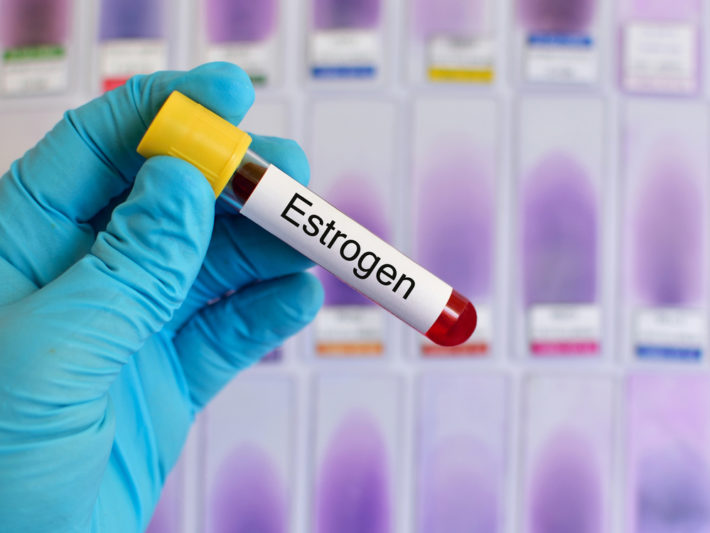
You’re always hearing about estrogen. You may be wondering if you should take it. This post answers the question whose answer you should know before that…”What is estrogen?”
You may know the first part of the answer to this question. It’s something I address in detail in my best selling book, The Estrogen Fix.
Estrogen is a steroid hormone that conjures up “all things female”: curvy bodies, breasts, ovaries–the stuff that turns a girl into a woman. While everyone is born producing some natural estrogen, when a girl enters puberty and throughout her reproductive years, estrogen levels are much higher. Chemically, estrogen is an arrangement of four chemical rings joined together that look like chicken wire.

The estrogen molecule
Hormones are in a class of what’s called signaling molecules because they are produced by an endocrine gland in one part of the body that communicates with, or “signals,” various other parts of the body to accomplish specific tasks, such as regulating bone health, boosting the body’s immunity, or influencing the timing of a woman’s monthly cycle. They regulate how our bodies function and how we think and behave.
A woman’s body makes three different forms of estrogen. They are estrone (E1), estradiol (E2), and estriol (E3). E1 is made in many tissues, especially fat. E1 is made in much higher quantities in obese women, which is one of the reasons why heavier women are more prone to gallstones and uterine cancer. E2 is largely produced in the ovaries. E3 is produced from the placenta during pregnancy.
THE THREE BIOIDENTICAL ESTROGENS
- E1 Estrone
- E2 Estradiol, 17&bgr;-estradiol
- E3 Estriol
These three hormones are the estrogens called bioidentical, no matter what type of pharmacy you buy them in. And no matter where you buy them they are not natural and are not naturally occurring in plants; they must be manufactured from compounds found in plants such as soybeans and wild yams. Humans don’t have the needed enzymes to turn plant compounds into bioidentical hormones. But once manufactured, they are bioidentical; they have the chemical structure identical to what the body makes naturally. These estrogens play different roles at different times in a woman’s reproductive life. Bioidentical is not a scientific term. Dr. Wulf Utian, founder of the North American Menopause Society, advocates that the correct term should be compounded hormone therapy (C-HT) if it is provided from a compounded pharmacy and government-approved hormone therapy if it is FDA approved from a traditional pharmacy. C-HT is not FDA approved.
Most of a woman’s estradiol is made in her ovaries, although some is produced in other tissue, such as the adrenal glands. The ovaries also make estrone, but most estrone is manufactured primarily in the body’s fat cells by a process called aromatization. The enzyme aromatase takes androgen (the so-called “male” hormones) and aromatizes or converts them into estrone. Just as you might guess, women who have more fat on their bodies make more estrone. More estrone is good news for some women because it may lower their symptoms of menopause. But too much estrone is also a major reason why women who are significantly overweight have a higher risk of uterine cancer–three times higher if they are 25 to 50 pounds overweight and nine times higher if they are more than 50 pounds overweight. At the opposite extreme, women who are too thin and who have too little fat on their bodies may stop having periods altogether because their bodies don’t produce enough estrogen.
Estradiol is the major estrogen produced by the ovaries before menopause. It is also the most potent–12 times more than estrone and 80 times more than estriol. After menopause, estradiol levels drop by as much as 90 percent because almost all of it comes from the ovaries, and they stop making it. Estrone levels drop by as much as one-third as the ovaries stop making it. But estrone does continue to be made in the body’s fat tissue, and obese women (more than 20 percent over ideal body weight) can make up to 40 percent more estrone than non-obese women. Other organs, including the brain, muscles, lungs, skin, and bone marrow can also convert androgens (male hormones) into estrone. The body makes only very small amounts of estriol except during pregnancy, when the placenta increases production of the hormone by more than a thousandfold. In contrast to estradiol and estrone, estriol does not appear to be linked with any increased risk of cancer, but this hasn’t been proven because enough studies haven’t been done.
The point of this information is that estrogen is a very important hormone for women that affects almost every part of their bodies. Estrogen levels fluctuate each month and in each phase of a woman’s life. When estrogen levels fluctuate, changes can be significant, and potentially affect all parts of the body. In perimenopause, hormonal fluctuations become very pronounced, sort of like they were in puberty, only in reverse order. And the impact on a woman’s body from top to bottom can be equally profound. To find out how much low estrogen levels are affecting your menopause symptoms, visit MenopauseQuiz.com.
And then comes menopause, with estrogen levels at only 10 percent of what they were at the peak of a woman’s reproductive years. Now it’s easy to understand how the many symptoms of menopause can slowly and steadily become part of a woman’s life.
